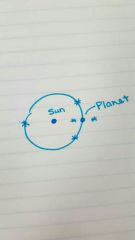![]()
![]()
![]()
Use LEFT and RIGHT arrow keys to navigate between flashcards;
Use UP and DOWN arrow keys to flip the card;
H to show hint;
A reads text to speech;
52 Cards in this Set
- Front
- Back
|
Most common elements in the solar system: |
Hydrogen, Helium, Carbon, Nitrogen, Oxygen. |
|
|
Mars "canals" |
Don't exist: optical illusion |
|
|
Mars color |
Orange-red |
|
|
Mars impact basins: |
Basically just big craters, biggest on Mars: Hellas |
|
|
Mars volcanoes |
Shield volcanoes, stay over hotspots: evidence Mars lacks plate tectonics. Biggest: Olympus Mons |
|
|
Mars atmosphere |
Thin, 90% carbon dioxide, 2% argon, 2% nitrogen. |
|
|
Uranus discovery date |
1781 |
|
|
Neptune discovery date |
1846 |
|
|
Pluto discovery date |
1930 |
|
|
Comet impact on Jupiter |
Shoemaker-Levy 9, discovered 1993, impacted 1994. |
|
|
Saturns active moons |
Titan and Enceladus |
|
|
Jupiters active moons |
Io and Europa |
|
|
Neptunes active moons |
Triton |
|
|
Plutos active moons |
Charon |
|
|
Active geology?: Venus |
Maybe |
|
|
Active geology?: Mercury |
No |
|
|
Active geology?: Mars |
Wind erosion, maybe in the past. |
|
|
Active geology?: Pluto |
YES |
|
|
Meteorites: Siderites |
Metallic (Fe&Ni) |
|
|
Meteorites: Siderolites |
Rocky and metallic |
|
|
Meteorites: Chondrites |
Rocky (most common!) |
|
|
Meteorites are... |
...fragments from asteroids. |
|
|
Comets: nucleus |
Coated in ice and dust |
|
|
Comets: coma |
"Cloud" of evaporated ice and dust when comet gets close to sun. |
|
|
Comets: tail |
Away from sun because of solar winds, longer because of coma. |
|
|
Asteroids: largest object in belt |
Ceres (600mi across) |
|
|
Asteroids: ~10% |
Metallic |
|
|
Asteroids: ~15% |
Rocky |
|
|
Asteroids: ~75% |
Carbonaceous (most common!) |
|
|
Closest to sun |
Mercury |
|
|
Farthest from sun |
Pluto (Neptune) |
|
|
Largest planet in solar system |
Jupiter |
|
|
Smallest planet in the solar system |
Pluto (Mercury) |
|
|
Planets with ring systems |
Saturn, Uranus, Neptune, (Jupiter kinda) |
|
|
Fastest rotation |
Jupiter |
|
|
Planets with no moons |
Mercury and Venus |
|
|
Most orbital tilt |
Pluto, 17° |
|
|
Most axial tilt |
Uranus, 98° |
|
|
Ring system particles |
Small: dust, rocks, icey bits Ring systems are inside the Roche limit. |
|
|
Roche limit |

The limit of how close something can get to a planet without being torn apart. |
|
|
Lagrangian point |

The 5 points on a single orbit in which different objects can be placed and still remain gravitationally stable. Co-orbital moons |
|
|
Main asteroid belt |
Between Mars and Jupiter |
|
|
Kuiper asteroid belt |
Icy objects, between Neptune and Pluto |
|
|
Apollo asteroids |
Asteroids that cross into Earths orbit. |
|
|
Trojan asteroids |
Asteroids that are co-orbital with planets |
|
|
Venus atmosphere |
97% carbon dioxide, 3% Nitrogen |
|
|
Circular/oval spots on outer planets |
Storm systems in the clouds |
|
|
"Belts" in the outer planets atmospheres |
Occour because the atmospheres move fast. |
|
|
Characteristics of atmospheres |
Needs a large mass for gravity, active geology, temperature (on the colder side) |
|
|
Tunguska event |
Comet hit earth in Siberia in 1908, flattened a bunch of trees. |
|
|
Planets without moons |
Venus and Mercury |
|
|
Slowest rotation |
Venus |

